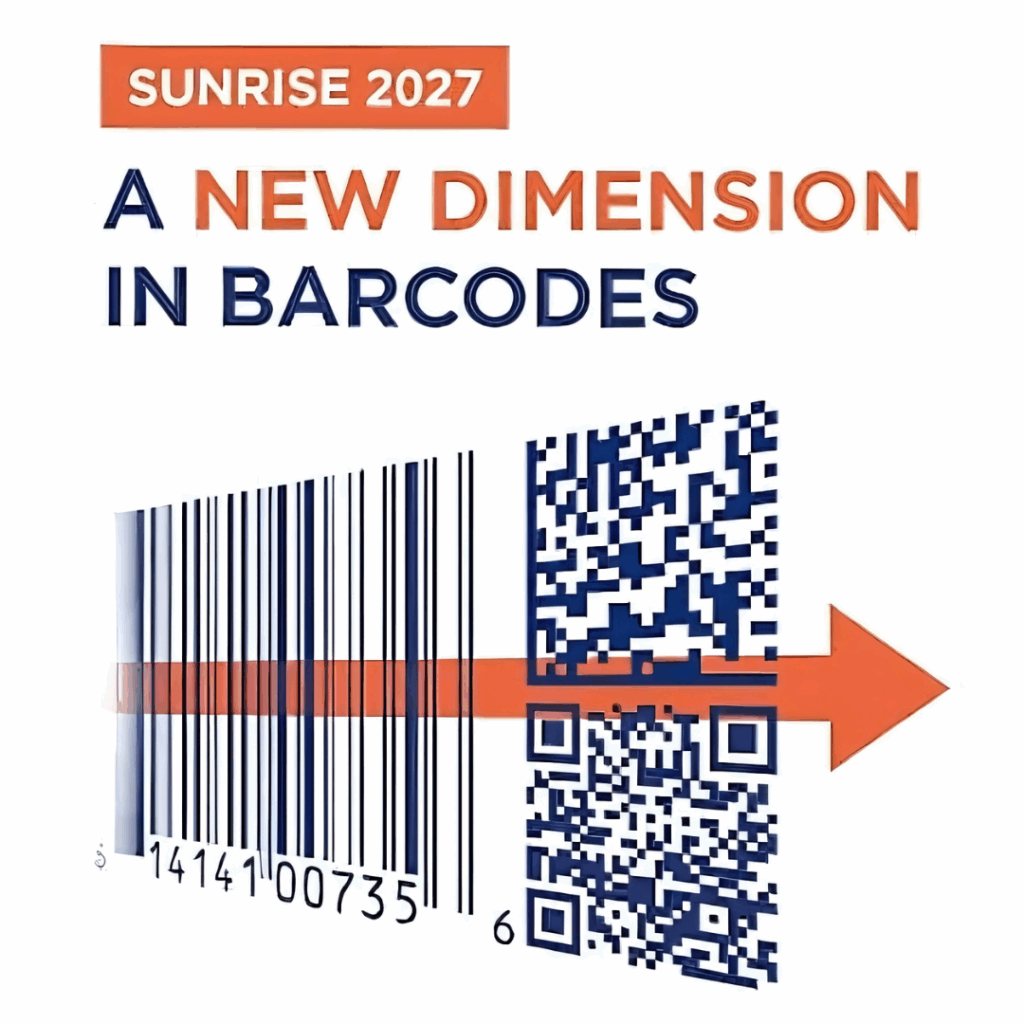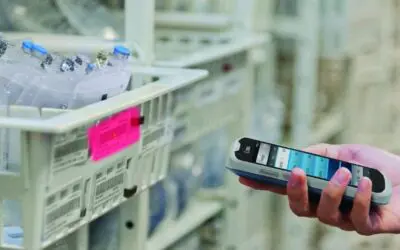In every corner of the supply chain — from manufacturing plants to retail checkouts and hospital bedsides — product data has become the fuel that keeps operations running smoothly and customers informed. But the barcodes most companies still rely on today — those familiar one-dimensional (1D) black-and-white stripes — just can’t keep up with modern demands for transparency, traceability, and product authentication.
That’s why the global supply chain is preparing for a significant technology shift, one you’ll be hearing a lot more about in the months ahead: Sunrise 2027.
By the end of 2027, retailers, manufacturers, healthcare providers, and supply chain partners will need to ensure their point-of-sale (POS) and point-of-care (POC) systems are equipped to read two-dimensional (2D) barcodes alongside traditional UPC/EAN barcodes. And for businesses that want to stay competitive, now is the time to start planning for this transition.
What Is GS1 Sunrise 2027?

Sunrise 2027 is an industry-led initiative to transition from 1D barcodes to 2D barcodes — such as QR codes or Data Matrix codes — at retail checkouts and healthcare point-of-care environments worldwide. This move is driven by the growing need for more detailed product information to support both consumer demands and operational efficiencies.
Unlike traditional barcodes, which typically only carry a product’s Global Trade Item Number (GTIN) for price lookup, 2D barcodes can hold a wealth of data. They offer endless possibilities for providing:
- Nutritional details
- Ingredient and allergen disclosures
- Country of origin
- Recall alerts
- Sustainability credentials
- Authentication verification
- And more — all in a single scan
According to a recent consumer survey:
- 77% of consumers say product information is important when making a purchase.
- 79% are more likely to buy a product with a scannable QR code that delivers additional details.
- 62% are even willing to spend more for products with accessible, comprehensive product data.
Businesses that adapt early will be best positioned to meet these expectations and stay ahead of the competition.
Why 2D Barcodes Matter: Industry Examples
The shift toward 2D barcodes isn’t just about satisfying consumer curiosity. It’s about solving real operational challenges and creating opportunities for innovation across industries. Let’s look at how different sectors stand to benefit:
Manufacturing
For manufacturers, 2D barcodes can significantly improve inventory management and traceability. A single scan can convey production dates, lot numbers, expiration dates, and other product-specific data — all essential for managing recalls, reducing waste, and ensuring compliance with quality and safety regulations.
Example:
An automotive parts manufacturer uses Data Matrix codes on individual components to track their assembly, installation, and warranty history. This enables faster root-cause analysis in the event of a defect and simplifies recall execution, minimizing downtime and protecting brand reputation.
Healthcare
In healthcare settings, accurate and immediate access to product and medication information is vital. 2D barcodes allow hospitals and clinics to track pharmaceuticals, medical devices, and supplies with enhanced accuracy, supporting safer patient care.
Example:
A hospital scans a 2D barcode at a patient’s bedside before medication administration. In addition to confirming the drug and dosage, the barcode provides expiry details, batch numbers, and manufacturer information — reducing the risk of medication errors and improving patient safety.
Retail
Retailers, especially those managing omnichannel operations, stand to gain operational efficiencies and richer customer engagement tools. With a single 2D barcode, businesses can enable price lookup at checkout, manage inventory, support digital coupons, and connect shoppers to product stories, promotions, and loyalty programs.
Example:
A grocery retailer prints QR codes on private-label products. Customers scan them for nutritional information, recipes, and sustainability practices while store associates use the same codes for stock checks, markdowns, and replenishment tasks — streamlining retail operations and boosting customer satisfaction.
Why Migrate Now?
While Sunrise 2027 may seem a few years away, updating infrastructure and processes takes time — and those who start early will benefit most.
Key reasons to act now:
- Protect your business continuity: Avoid operational disruptions by gradually updating barcode scanning devices, POS software, and inventory systems now.
- Enhance operational efficiency: Leverage richer data for better supply chain management, recall readiness, and inventory control.
- Improve consumer engagement: Offer customers the information they increasingly demand, right at their fingertips.
- Strengthen brand trust: Transparent product data builds customer confidence and loyalty.
- Stay ahead of competitors: Early adopters can use 2D barcodes as a differentiator, offering added value before the mandate takes hold.
How MSM Solutions Can Help
At MSM Solutions, we’ve spent years helping manufacturers, retailers, and logistics providers optimize operational efficiency with modern barcode technology and data capture solutions. From selecting the right 2D-capable scanners and barcode label printers designed for your unique requirements to integrating them with your existing systems and processes, our team is ready to guide you through this important technology transition.
Whether you’re considering color label printing for product packaging, mobile barcode scanning devices, or complete inventory management solutions, MSM Solutions can help you harness the full potential of 2D barcode technology now — and be ahead of the curve.
Additional Resources
To learn more about Sunrise 2027 and the future of barcode technology, check out these helpful resources:
GS1 Digital Link Explainer Video
Global Joint Industry Statement on 2D Barcodes
The supply chain world is evolving, and the way we label and track products needs to evolve with it. Sunrise 2027 isn’t just a deadline — it’s an opportunity. By adopting 2D barcode technology early, you can future-proof your operations, exceed customer expectations, and position your business as a leader in product data transparency.
Ready to take the next step? Contact MSM Solutions today to learn how we can help you prepare for the future of barcode technology.


